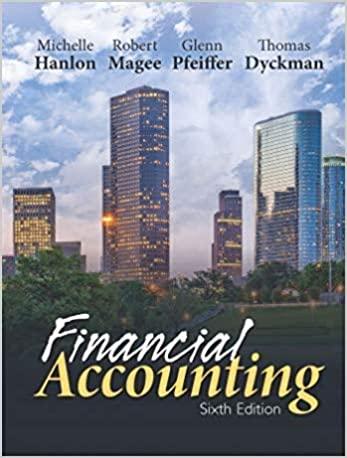Question
Gin and Tom Ltd is a clothing wholesaler, which has been operating for only 1 year. At the beginning of its second year of operations,
Gin and Tom Ltd is a clothing wholesaler, which has been operating for only 1 year. At the beginning of its second year of operations, the company has the following items on its balance sheet:
Fixed Assets | 2,000 |
Cash | 2,000 |
Common Stock | 400 |
Retained Earnings | 600 |
5- year Bank Loan | 3,000 |
During the second year, the company did the following transactions:
- Purchases inventory (clothing) for $700, on credit.
- Sells inventory, which originally cost $600, for $1,400. Half of the customers buy on credit and the other half pays in cash.
- Pays $150 at advertising and $75 at insurance. The advertising is paid in cash; however, the insurance will be paid in cash later.
- Purchases a new storage facility for $600, on credit.
- Pays the warehouse employees $200 in cash.
- Pays interest of 10% on its loan, in cash.
- Pays $400 for accounts payables.
- Receives $400 from its customers.
- The company's accountant calculates that because of the above transactions, the company will have to pay tax of $100 later.
- The board of directors decides to pay a dividend of $50 (the dividend is not paid by the end of the fiscal year).
You are given a worksheet for Gin and Tom Ltd's second fiscal year. Fill in the opening balances (from the end of the first year) and record the transactions during the second year. Calculate closing balances and then, using the formats given, create a closing balance sheet and an income statement.
TRANSACTION WORKSHEET
| ASSETS | SHAREHOLDERS' EQUITY | LIABILITIES | |||||||||
| Fixed Assets | Inventory | Acc Receiv | Cash | Comm Stock | Ret Earning | Income State | Bank Loan | Acc Payable | Tax Payable | Dividends Payable | |
Opening balances | |||||||||||
| Purchase inventory | |||||||||||
Sales | |||||||||||
Cost of sales | |||||||||||
Insurance | |||||||||||
Advertising | |||||||||||
Purchase storage fac. | |||||||||||
Salaries | |||||||||||
Interest | |||||||||||
Pay accounts payable | |||||||||||
Collect accounts rec. | |||||||||||
Tax | |||||||||||
Dividend | |||||||||||
Transfer retained earnings | |||||||||||
Closing balances |
Income Statement
Sales | |
Cost of Sales | |
Gross Profit | |
Operating Expenses | |
Profit before Interest and Tax | |
Interest | |
Profit Before Tax | |
Tax | |
Profit After Tax |
Balance Sheet
CURRENT ASSETS | ||
Cash | ||
Accounts Receivable | ||
Inventory | ||
Total Current Assets | ||
FIXED ASSETS | ||
Plant and Machinery | ||
Total Long Term Assets | ||
TOTAL ASSETS | ||
CURRENT LIABILITIES | ||
Accounts Payable | ||
Dividends Payable | ||
Tax Payable | ||
Total Current Liabilities | ||
LONG TERM LIABILITIES | ||
Bank Loan | ||
Total Long Term Liabilities | ||
TOTAL LIABILITIES | ||
SHAREHOLDERS' EQUITY | ||
Common Stock | ||
Retained Earnings | ||
Total Shareholders' Equity |
Step by Step Solution
There are 3 Steps involved in it
Step: 1

Get Instant Access to Expert-Tailored Solutions
See step-by-step solutions with expert insights and AI powered tools for academic success
Step: 2

Step: 3

Ace Your Homework with AI
Get the answers you need in no time with our AI-driven, step-by-step assistance
Get Started


